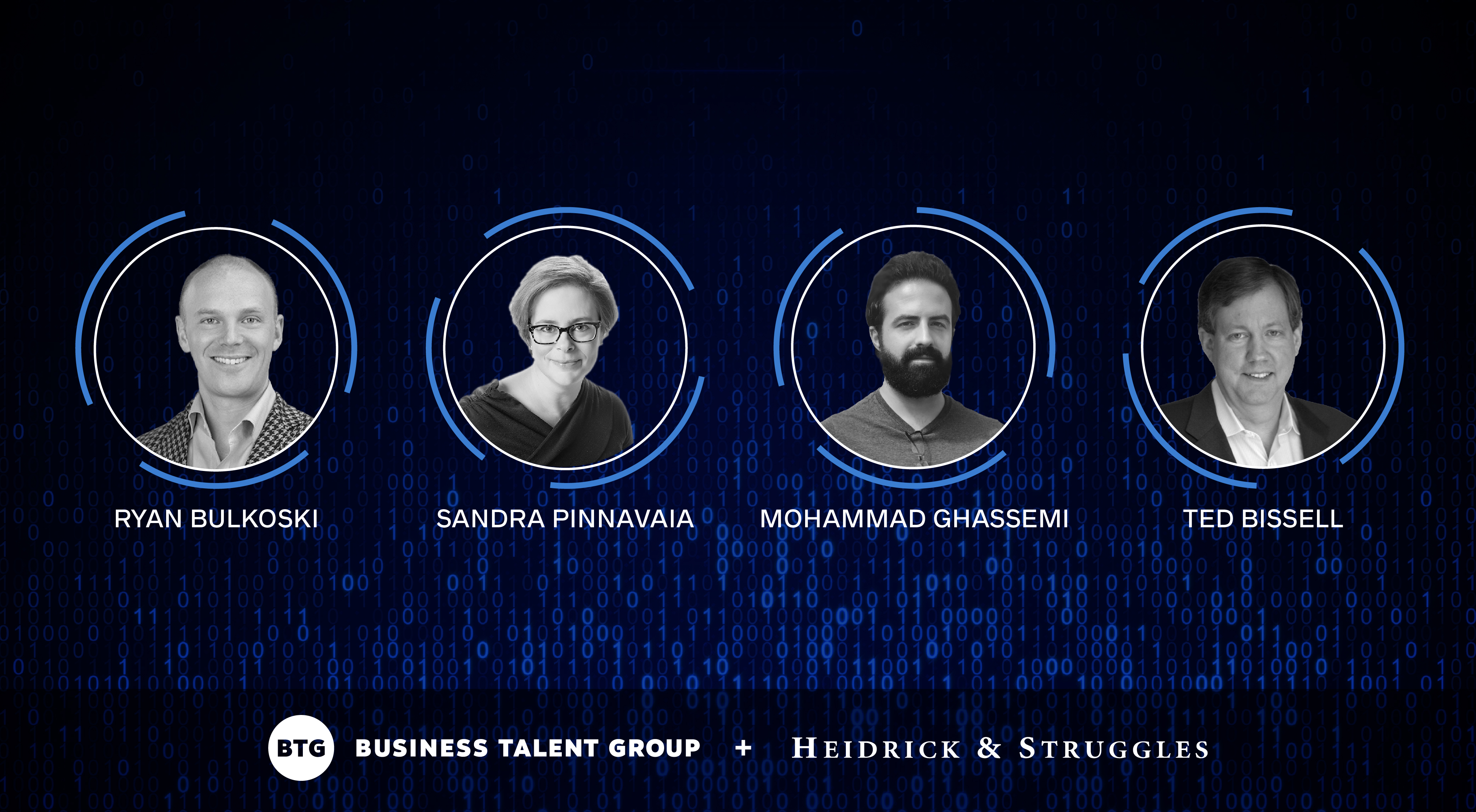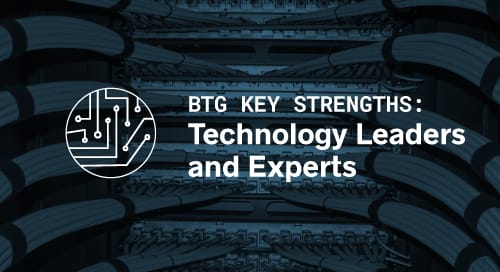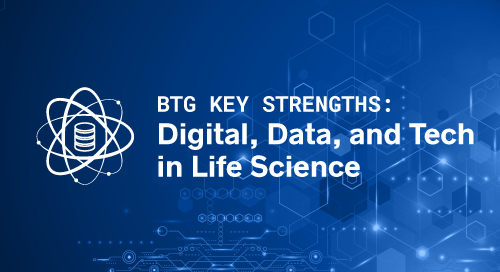
The data your business already collects can help you rethink strategies, streamline processes, understand and interact with customers, and power new products and services.
Unfortunately, only 18% of companies believe they can gather and use data insights effectively. Companies can see where they want to go, but most of them simply cannot find enough data science talent to get there. Executives are also struggling with how to organize around this topic—is it a new function? What are the key leadership roles? How do AI and data science integrate into existing functions?
Business Talent Group and Heidrick & Struggles organized a webinar to tackle these and other data science challenges. Below is a lightly edited version of a discussion that Business Talent Group’s EVP, Sandra Pinnavaia, had with Heidrick & Struggles Global AI Practice Lead, Ryan Bulkoski, and independent data science experts Mohammad Ghassemi and Ted Bissell.
Do you think companies should centralize their data science efforts under something like a chief data officer or keep them distributed across the organization?
Ted: In my experience, the answer to that question depends on where the company is starting from. The basic analytics capabilities that are baked into many popular IT platforms may be enough to help a company reach its basic goals, in which case it makes sense to keep things distributed. But the moment you reach a point where you’re putting sensitive data at risk or changing the level of effort or intensity with respect to what you source and collect, and why, you’ll likely need the sort of transparency that centralization offers.
Ryan: I’ll echo Ted—it depends. In massive global companies that have been around for decades, it’s really hard to take a centralized approach, just because the data sits in so many different areas. In smaller organizations that might be tackling for this for the first time, it does make a lot of sense to centralize. Of course, there’s also a hybrid methodology where you build a hub-and-spoke model to ensure there’s good governance and oversight at the center, which then informs the work of individual businesses and functions.
Mohammad: I see pros and cons to both approaches. Centralization makes it easier to scale and deploy certain algorithmic frameworks and operations across an organization. The con is that it can be time-consuming to get various stakeholders to adhere to those centralized policies. If, on the other hand, you allow your teams to define how they structure data and create APIs to transact information, it allows you to operate more quickly, but as you start to scale, it creates problems.
For companies that are trying to centralize, where should those key leadership roles fit within the organization?
Ryan: Historically, many companies incubated data science and AI roles within the technology function. That sounds like a natural place, but over time, it’s become clear these roles can drive a lot of commercial value, so people are rethinking that.
At times, a Chief Data and Analytics Officer might report directly to the CEO. The function might also report to the CFO, so there’s a tie into the organization’s money line. I’ve also seen it report into the Chief Operating Officer for the same reason. But really, the higher up it is within the organization, the more visibility it will have, and that really serves as a great recruiting tool, because it shows the company is prioritizing their investment in data and analytics.
Many companies have a very hard time recruiting qualified data science and AI talent. Mohammad, you’re in touch with a lot of folks that are coming out of school. What suggestions do you have about attracting and retaining them?
Mohammad: This is a timely question because I was just speaking to a student a few days ago who was grappling with the decision to take a $350,000 job at a major tech company or continue eating ramen noodles while working on a start-up that was a passion project. We went through the pros and the cons, but ultimately this student decided to go for the project he was passionate about. And that’s one of the factors that can really provide a competitive edge to organizations that are looking to grow their data science teams. If people feel like they will be solving very interesting problems with AI and data science, and will get recognition and opportunities for growth, my pulse on the talent pool is that they really value that—more than they value brand names and sometimes even salaries.
How does geography factor into these recruiting challenges?
Ryan: Geography is definitely a challenge, and often people assume they won’t be able to recruit anyone if they’re not based in the Bay Area. There’s a lot of talent in the Bay Area, but there are plenty of people in other hot spots around the world. In this world, a recruiting decision can come down less to geography and more to the challenge that’s presented to the individual. Most people will be motivated to move for the right opportunity, especially if it represents an up-leveling and greater exposure to the C-suite.
Of course, permanent employees aren’t the only way for companies to build robust data science capabilities. Independent data science experts can help companies refine strategies and lead important projects. Mohammed and Ted, what have you learned about that from your recent project work?
Mohammad: One of my latest projects was with a large financial institution based out of Latin America. They were interested in using data both within and outside of their organization to make better strategic decisions about investments, loans, and various other things within the market ecosystem.
Over the course of the project, we were able to help the company’s decision makers understand not just how to grow their data science capabilities in the short, medium, and long term, but also, very critically, how to recognize what components of data science it was strategically advantageous to outsource. For most companies, it makes sense to specialize in specific data science capabilities. In the case of this financial institution, predictive analytics was a big one. Something like the collection of satellite imagery, on the other hand, was less important for them to build up as a core capability.
How was the fact that you came in on a project basis useful to this client?
Mohammad: Having somebody who comes in with an independent lens has a couple of distinct advantages. First is the ability to help stakeholders tease out which factors are important to the success of the engagement—to simplify their train of thought and identify key directions. Another is the ability to help the client prioritize their opportunities relative to what other industries are doing. I’m not necessarily an expert in the Latin American investment ecosystem, but I do have experience in the U.S. and Middle Eastern markets that I can help them translate over.
Ted, what projects have you worked on recently in data science and advanced analytics?
Ted: One project I did recently was with a major US insurer. Insurance companies have always assigned a high priority to analytics, but in the case of this insurer, they wanted to go a little bit further and use data to create products that protected and enhanced value in the home.
In the age of IoT, smart home technologies are collecting a lot of intimate data for the first time. Overlaid on that are privacy concerns, but there’s also an opportunity to create new communications channels for a company that typically distributes its products through human agents. As we examined what this product might look like, we had to add new approaches to the company’s existing analytics capabilities. I think that’s one of the reasons that the company wanted to get an independent view. They already had hundreds of data scientists at their disposal, but they weren’t really sure what this new team would look like once the product launched. Would it focus on the digital interface? Would it emphasize machine learning and algorithms or risk management?
As it turned out, the company decided to mix a number of these different capabilities in a single team, and now that they’re operational, they’ve been able to use those learnings to form a much better view of whom to hire and what capabilities to pursue.
What projects or situations are better suited for independent consultants, and when should you hold out for a permanent hire?
Mohammad: I think it comes down to evaluating whether your company has a strategic reason for developing a long-term capability around a particular area of data science—like predictive analytics, in the case of the organization I mentioned earlier. If so, I think it does make sense to have a person who is permanently involved, though when you’re getting started or if you need to grow quickly, you can also augment that person’s work with independent experts.
Another situation where independent expertise makes sense is in some of the more technical areas of AI. AI refers to a ton of things, from image processing to natural language processing, and the Ph.D. students that are graduating tend to specialize in only one of them. So independent experts are great for augmenting an organization’s core AI capabilities with one of those specialties.
Finding talent is only part of the battle. What other steps do you recommend that companies take as they start to do more with data?
Ted: One of the things you need to start with is at least a hypothesis of what you’re trying to do with this capability. Are you trying to grow your company’s product lines? Are you looking to prevent customers from going to the competition? On the cost side, are you trying to increase the efficiency of the way you serve existing customers or even run the organization itself?
You’ve also got to formulate what that means for the organization, because that enables you to start scoping. Are we talking about a huge project to reform some IT systems that can’t keep up with current data volumes? Are we trying to test where the best place is to get some quick wins? And do we have buy-in from across the organization so that everyone is ready to invest?
Setting clear goals and priorities sounds so obvious and easy, but many companies still struggle with it. Mohammad, what’s your perspective?
Mohammad: I agree with Ted. At the start of my engagements, I often ask people to identify two or three things that, if automated, would provide some kind of ROI. Then, I take them through the exercise of trying to quantify that savings or value. The same is true for engagements that are about augmenting, not replacing, human processes. Where could you increase employee performance or improve your ability to sell or price a product or service more effectively? Once that’s done, we can take the secondary step of analyzing what kind of resources you’d need to invest, both human and financial, in order to get there.
What do you think are the most critical things for corporations to have in place before bringing in a data science or AI expert, whether on a project basis or at the permanent hire?
Ted: First of all, you need to understand how you are holding data. Evaluate the performance of your systems and the quality of your data. If you’re dealing with multi-year datasets, how far back do they go, and have you tested to make sure they are consistent? You’ll also need to understand the covenants you’ve made with your customers about the use of data, especially if you’ve been around for a while. You may never have explicitly told your customers that you’re collecting all the data that you actually have on hand.
Second, you’ll need to understand where you are headed with respect to your competition. How much of your customer base is under threat by other companies that are moving faster than you or have committed to more data-centric processes?
Ryan: I think it’s really important for the organization to go through an education on why they are doing this. What is the ultimate takeaway from investing in data and analytics? Does everyone understand the different use cases—where they’ll make money and where they’ll save it?
Ted, are there any other practical insights you can offer companies from your experiences as a consultant?
Ted: One of the problems I think we’ll face in the next 12 months is that, increasingly, IT and analytics platforms are touting all kinds of great capabilities. So it will seem increasingly easy to install a new platform and start running analytics. But usually, for these platforms to function well, they need live client data. And if you’re talking about a bank or a healthcare organization, it’s not a trivial matter to just open up a port and start getting that. So suddenly, we reach kind of a cathartic IT and business moment where these issues must be overcome before progress can be made.
What do you think about people analytics—should companies do more in this realm?
Ryan: We’ve seen a lot of demand, but largely from Fortune 500 organizations. Part of the challenge with people analytics is you need enough people to analyze if it’s going to be successful. We’ve seen a lot of success in global multinational corporations, whether they’re looking at geographic expansion and figuring out where employees should be based, analysis from a compensation perspective, predictive analytics on retention based on someone’s career path, and even using analytics to promote diversity within the workforce. But at a 1,000-person company, these techniques might not be as fruitful as in a 100,000-person company.
What are the biggest data science challenges that companies must overcome?
Ted: Many companies have a sense that they’re underutilizing much of the data that they already have on hand. But legacy data doesn’t just plug itself into algorithms. Chances are, past data wasn’t collected with the goal of supporting robust analytics, so there’s likely to be inconsistency in data standards. Over time, IT systems probably shifted from mainframe to minicomputer to PC to cloud, which all rely on different data storage formats and media. Companies might need to augment gaps with third-party data, but they might not know what cost is justified.
The solution to all of these challenges is a robust business case that outlines the expected upside and incorporates the cost of aligning the right data, plus testing and deploying repeatable models. In any large organization, that amount of money is likely to fall in the approval range of the C-suite, forcing the creation of and agreement to a shared vision.
GET THE SKILLS YOU NEED
Thousands of independent consultants, subject matter experts, project managers, and interim executives are ready to help address your biggest business opportunities.
About the Author
More Content by Leah Hoffmann















